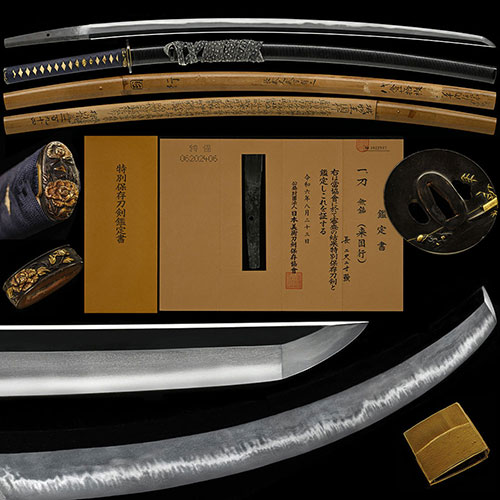
来国行 刀 Rai Kuniyuki Katana
No.591983刀 来国行 鎌倉中期 久松松平家伝来 金無垢目貫千段刻鞘打刀拵付 足葉飛び焼き金筋砂流し頻りに掛る傑作 二尺二寸Katana Raikuniyuki, Middle Kamakura period, A masterpiece 66.8cm, Handed down by the Hisamatsu Matsudaira family, Kinmuku Menuki, With Sentan-kokusaya Uchigatana Koshirae, There are Ashi and You frequently with Tobiyaki ,Kinsuji and Sunagashi-shikirinikakari, A masterpiece 66.8cm
商談中Hold
- 極めKiwame
- 来国行 来国行 Rai Kuniyuki
- 登録証Registration
- 岐阜県 Gifu 昭和40年2月26日 2/26/40(Showa)
- 時代Period
- 鎌倉中期 正元頃Middle Kamakura period, Syougen period
- 法量Size
-
刃長 66.8cm (二尺二寸) 反り 1.6cm
元幅 2.6cm 先幅 1.6cm 元重 0.55cm 鎬厚 0.64cm 先重 0.37cm 鋒長 2.3cm 茎長 14.2cm 重量 543gHachou 66.8cm (二尺二寸) Sori 1.6cm
Moto-Haba 2.6cm Saki-Haba 1.6cm Moto-Kasane 0.55cm Shinogi-Thikess 0.64cm Saki-Kasane 0.37cm Kissaki-Chou 2.3cm Nakago-Chou 14.2cm Weight 543g - 国Country
- 山城Yamashiro
- 姿Shape
- 鎬造、庵棟、身幅やや細く、反りやや深く、小鋒。Shinogidukuri, Iorimune, Slightly narrow Mihaba, Slightly deep Sori, Small-Kissaki.
- 鍛Kitae
- 小板目肌つみ、柾目肌交じり、地沸微塵に厚くつき、地景よく入り、映り立つ。Small-Itamehada-tsumi, Mixed Masamehada, Jinie entered fine and thick, Chikei entered frequently, Utsuritatsu.
- 刃文Hamon
- のたれて、互の目に、丁子刃交じり、湯走り・飛び焼き頻りに掛り、足・葉頻りに入り、小沸よくつき、金筋・砂流し頻りに掛り、匂口明るい。Notarete, Gunome, Mixed Choujiba, Yubashiri, Tobiyaki-shikirini-kakari, There are Ashi and You frequently, Small-Nie entered well, Kinsuji and Sunagashi-shikirini-kakari, Nioikuchi is bright.
- 帽子Boushi
- のたれて先尖って浅く返る。Notarete-Sakitogatte Asaku-Kaeru(shallow return)
- 茎Nakago
- 大磨上、先浅い栗尻、鑢目筋交、目釘孔一。Ohsuriage, Tip Shallow Kurijiri, Yasurimesujikai, Mekugiana is one(1)
- ハバキHabaki
- 金着二重。Double Kinkise
- 拵Sword mounitings
- 黒蝋色千段刻鞘打刀拵 [江戸時代]
法量
長さ99.0cm 反り4.5cm
説明
鐔 赤銅磨地曳舟図金色絵。 縁頭 赤銅魚子地牡丹図金色絵。 目貫 金無垢地牡丹図。
Kuro-Rouiro(Black wax colored) Sentan-kokusaya Uchigatana Koshirae(Edo period)
Length:99.0cm
Sori:4.5cm
Tsuba:Syakudou Migakiji Hikifunezu Kiniroe
Fuchigashira:Syakudounanakoji Botanzu (peony design)Kiniroe
Menuki:Kinmukuji Botanzu(peony design) - 説明Drscription
- 山城物の中で最も多いのが来派の作品で、鎌倉中期から南北朝時代に渡り栄えている。一派の祖は国行で、国俊・国光・国次・国真・倫国などの名工が排出している。国行は観智院本銘尽に「らい太郎」としてその名があり、「常に広直焼足太く入る」とその特色を示している。製作年代は子と伝える国俊の作に弘安元年(1278)紀の太刀があり、それから推して国行は銘鑑に記す通りほぼ正元(1259)頃と考えられる。
この刀は、身幅やや狭く、輪反りで、小鋒となる優雅な体配で、地沸が微塵に付き、小板目肌つみ、柾目肌交えた地鉄に映り立ち、のたれに、互の目・丁子刃など交え、湯走り・飛び焼き頻りに掛り、足・葉頻りに入り、華やかに乱れ、輝く小沸が厚くつき、金筋・砂流し頻りに掛る、古雅で品格溢れる傑作である。江戸時代の鞘書に松平内膳正遺物とあり久松松平家の伝来品である。Among Yamashiromono, the most common works are those of the Rai school, which flourished from the mid-Kamakura period to the Nanbokucho period.
The origin of this school was Kuniyuki, and master craftsmen such as Kunitoshi, Kunimitsu, Kunitsugu, Kunizane, and Tomokuni were produced. Kuniyuki is known as ``Raitaro'' in Kanchiin Bonmeidukushi, and its characteristics are expressed as ``always entering Hirosuguyaki Ashi thickly.'' There is a Tachi made in the first year of Koan (1278) by Kuniyuki, who is said to have been a child, and it can be assumed that Kuniyuki was made around the first year of the Shogen era (1259) as written in his inscription.
This sword has narrow Mihaba, Wazori, elegance appearance with Small-Kissaki, Jinie entered finely, Small-Itamehada-tsumi, Mixed Masamehada with Jigane-Utsuritachi, Notare, Gunome, Mixed Choujiba, Yubashiri, Tobiyaki-shikirini-kakari, There are Ashi and You frequently, Gorgeouse Midare, Shining small-tie entered thickly, Kinsuji and Sunagashi-shikirinikakaru. It is a masterpiece of elegance and dignity. In the Sayagaki of the Edo period, it is stated to be a relic of Matsudaira Naizen and is an article of the Matsudaira Hisamatsus handed down.



